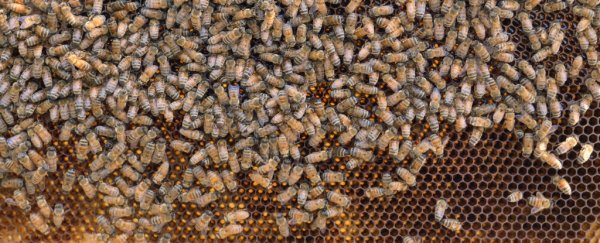The honey bees had taken up residence inside the walls of the house.
A homeowner in Hillside, New Jersey, near Newark, told CBS New York it was "really noisy" with honey bees "humming and huddled up together." But he had no idea just how many bees had been lurking behind those walls.
In fact, there were about 30,000 of them - and about 40 pounds of honey, according to a beekeeper who was called to remove them.
Video (embedded below) shows the moments after the beekeeper opened one of the walls last month.
"This is insane," Mickey Hegedus said in the video.
"What I'm doing is I'm slowly cutting out each piece of lath - and as I do it, it just exposes more bees and more honey and more comb," the third-generation beekeeper said in the video, as bees buzzed and darted from a large hole in the wall and latched onto his protective suit.
"These are Africanised - these are the most aggressive bees I think I've ever cut out of a hive."
Hegedus, known in the New York and New Jersey area as Mickey the Beekeeper, told The Washington Post that it appeared that the bees had been getting into the house through an outside opening meant for electrical wiring.
Because these bees are so aggressive, they're better foragers and collect more honey and build more comb than most bees; they're also more defensive, he said. All of those factors, along with a warm spring, contributed to the hive's large size.
Hegedus was called to the home Sept. 30 to remove them.
Generally, exterminating bees is considered a last option, according to the New Jersey Beekeepers Association, which says honey bees "should be left alone unless their hive is in conflict with human activity."
 The bee colony hiding in the walls of a New Jersey home. (Credit: Courtesy of Mickey Hegedus)
The bee colony hiding in the walls of a New Jersey home. (Credit: Courtesy of Mickey Hegedus)
In such cases, the bees can be removed but "should be killed only as a last resort. Except for colonies residing within buildings or other indoor structures, it is illegal in some states (e.g. NJ) to kill honey bee colonies without approval from appropriate agencies," according to an association pamphlet.
After Hegedus confirmed that they were honey bees, he said, he drilled a small hole in the wall and put in a camera to see the swarm behind it.
One or two of the bees escaped from the small hole and Hegedus said, "one flew right at my head and into my hair and started stinging me."
When he opened the wall, he said, "they were all over me." He said he got stung about 30 times, mainly around his wrists where his gloves met his protective suit.
Hegedus said he used a special vacuum attached to a beehive box to gently suck some of the bees from the wall cavity - and off himself.
"I had to - they wouldn't stop," he said, adding that he then cut the comb and put the pieces into other beehive boxes - a process that he said took about five hours.
Hegedus said he was able to save about 95 percent of the hive, but because the bees were so aggressive, he was not able to keep them or give them away.
Instead, he said, he released them into an isolated area in Mountainside, New Jersey.
2017 © The Washington Post
This article was originally published by The Washington Post.
